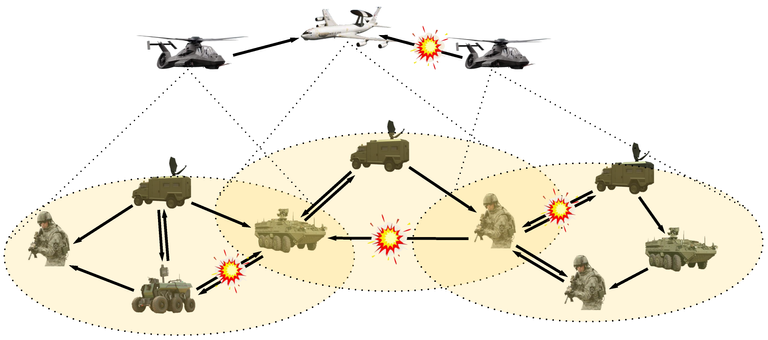Advancements in Warfare - The Internet of Battlefield Things (IoBT)
INTRODUCTION
By combining various intelligent devices together with the Internet forms a large scale network known as the Internet of Things (IoT). With this IoT, real time exchange of information and communication among devices is made possible. It is this resulting technology which is expected to play a major role in the improvement of combat effectiveness and situational awareness abilities of the military in the performance of their duties. By connecting combat equipment with other necessary battlefield resources the Internet of Battlefield Things (IoBT) is created.
THE US ARMY REASEARCH LABRATORY'S $25 MILLION IOBT PROJECT
As part of a new $25 million initiative funded by the Army Research Lab, the University of Illinois at Urbana-Champaign will lead an initiative with six schools and a research center to bring smart home capabilities to the battlefield. "The goal of this program is the development of new intellectual foundations and new knowledge,' said Tarek Abdelzaher, a computer science professor who's heading the initiative for U. of I. 'How do we empower the U.S. Army to have a higher competitive advantage in a world where adversaries are becoming increasingly technologically sophisticated?" [Holly, R. Chicago Tribune. "The Army wants smarter tech gear. U. of I. is leading the charge." https://www.chicagotribune.com/business/blue-sky/ct-bsi-iobt-u-of-i-20171011-story.html. (Accessed June 25 2021)].
The ultimate goal of this research is to take the various physical devices presently in use in the battlefield and find better ways to connect them into a seamless network which using intelligence operates so as to keep soldiers safer. According to the Research Team:
Sensors, cameras, weapons, vehicles, collected data and algorithms are all over the place — in armor, in soldiers' wearables, on the ground and in the sky.... We want to configure them, to bring them together to create one of millions of possible tools that can best accomplish the right mission.... We don't want to micromanage the machines and things doing the work.... I want to tell (the machines) my intent, and then I want them to have the sort of intelligence, autonomy and initiative to figure out how to meet my intent.
[Id.]
In transforming current battlefield operations into a large scale IoBT endeavor draws upon data analytics, information theory, game theory, and distributed learning. However, the Researcher's note that many complex variables must be considered to create a viable deployment strategy. "These variables include heterogeneous sets of data sources, the rapidly shifting makeup of the battlefield environment, the wide-ranging capabilities of smart items, the need to account for human behavior on the battlefield, and the adversarial nature of the IoBT due to the possibility of malicious attacks." [ECE News. "Laying groundwork for the Internet of Battlefield Things". https://ece.vt.edu/news/article/the-internet-of-battlefield-things". (Accessed June 26, 2021)].
To achieve this IoBT, predictive intelligence, making use of recent advancements in artificial intelligence, machine learning, and neural networks are all incorporated into the research mix. If successful the tools currently utilized in battlefield operations may acquire the operative autonomous intelligence and initiative to shield human soldiers from harms way.
The US Army's long range plan to keep pace with its adversaries and other technological advances rests in the current research involving the IoBT. The systems presently in place utilized by the military require evolution beyond the existing networked systems. The resulting heightened degree of system sophistication will require complex mathematical usages to represent, reason and understand today's systems while providing analytics of a predictive nature within battlefield dynamic environments. The specific focus of the ARL in this regard includes:
- Discovery, Composition and Adaptation of Goal-Driven Heterogeneous IoBTs: Novel mathematical theories and scientific insights leading to scalable composition and management of heterogeneous IoBTs enabling secure information sharing to meet multiple dynamic mission goals.
- Autonomic IoBTs to Enable Intelligent Services: Theoretical foundations, models, and methods of autonomic complex systems that deliver adaptive cyber-physical capabilities and services necessary to enable effective command and control across military (blue), adversary (red), and civilian (gray) domains.
- Distributed Asynchronous Processing and Analytics of Things:
Scientific principles, theories, and methods and predictive processing, analytics, and anomaly detection of broadly heterogeneous and varied data that may be unknown combinations of sparse and voluminous; centralized and distributed; and trusted and suspect for the purposes of augmenting goal-driven decision-making.- CCRI: Cyber-Physical Security: Theoretical and pragmatic cross-cutting methods that address the challenges of the above research areas, while enriching the resiliency of the IoBT, such that it can be hardened against tampering and adversarial compromise, continue operating under attacks, and provide bounded guarantees of performance.
[Army Research Laboratory. Internet of Battlefield Things. https://www.arl.army.mil/business/collaborative-alliances/current-cras/iobt-cra/. (Accessed June 25, 2021)].
CONCLUSION
Having fought relatively low-technology battles in Iraq and Afghanistan during the past two decades, the Army has failed to keep pace with more advanced potential enemies such as China and Russia in the area of Electronic Warfare. Research as discused herein leads the US military to its first steps toward a parity in battlefield technology with its potential enemies. The $25 Million earmarked by the ARL for this IoBT project covers a period of five years, and if significant progress is shown the project may be extended for an aditional five years with an estimated cost of $32 Million.
Posted Using LeoFinance Beta
